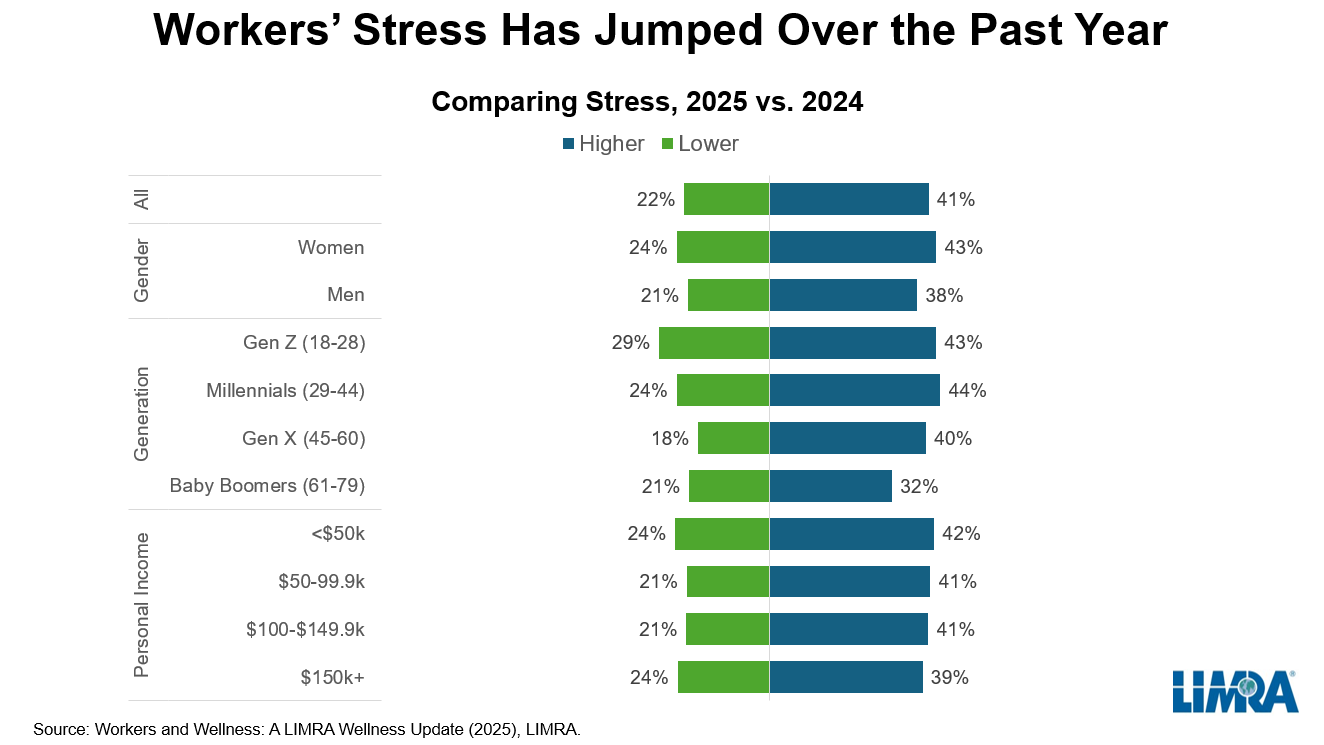Media Contacts
Catherine Theroux
Director, Public Relations
Work Phone: (860) 285-7787
Mobile Phone: (703) 447-3257
10/22/2025
As financial stress continues to rise among American workers, the role of employer-sponsored wellness programs has never been more critical. In the latest episode of LIMRA’s Industry Insights, Bryan Hodgens, senior vice president and head of LIMRA Research, and Deb Dupont, assistant vice president and director of LIMRA’s Institutional Retirement Research, explored the growing demand for holistic wellness initiatives and their impact on employee satisfaction and productivity.
Rising Stress Levels and the Need for Support
LIMRA’s Consumer Sentiment Study shows a third of Americans have continuously reported high stress about their household finances since 2020. Stress related to jobs and careers runs a close second. A new LIMRA study finds, across the board, that overall employee stress has increased in the past year. Workers are nearly twice as likely to report experiencing more stress than they are to say their stress has declined, with money and finances as the main cause.

To better understand and address these challenges, LIMRA developed the Financial Wellness Index in 2022. This tool measures wellness across three dimensions:
Importantly, financial wellness is deeply intertwined with physical and mental health. Four in ten workers attribute declines in these areas to financial stress, especially among Gen Z and Millennials, who are more socially connected and economically impacted.
LIMRA’s Financial Index revealed the aggregate wellness score (on a scale of 1-10) dropped from 5.7 in 2022 to 4.9 in 2024. Women, younger workers, single/divorced individuals, and those with lower income or education levels were most vulnerable. However, stress is rising across all groups, as consumers face persistent inflation and greater economic uncertainty.
The Employer’s Role: From Benefits to Wellness
Employers are increasingly expected to support their employees’ well-being. LIMRA’s research shows that:
“Wellness itself is a difficult concept to define; it means different states and situations to each individual. Whatever the qualifier, however, wellness can be considered the opposite of stress. Identifying the impediments to wellness can be key to achieving it,” said Dupont. “For many, a paycheck is the foundation for financial wellness. Benefits are also integral to wellness. Employers are in the wellness game and providing benefits is a wellness offering.”
Despite this, awareness remains low. Over 60% of workers are unsure if their employer offers a wellness program, and only one third of employers actively communicate about them.
ROI and Strategic Value of Wellness Programs
Beyond altruism, wellness programs offer tangible benefits to employers. They reduce turnover, enhance productivity, and foster loyalty. Workers enrolled in wellness initiatives report significantly lower financial, emotional, and physical stress.
“Obviously, stress of any sort can undermine a worker’s productivity, as well as their outlook about their employer,” noted Hodgens. “It’s important for employers and the service providers that help deliver benefits, fully understand workers’ stress as they design benefits programs and build programs to help workers manage their situations and work toward achieving wellness.”
Research shows wellness programs are no longer optional — they are expected and essential. Employers don’t need elaborate systems; even modest, well-communicated programs can make a meaningful difference. Partnering with benefits providers and leveraging existing resources can help employers meet the growing expectations of their workforce.
Director, Public Relations
Work Phone: (860) 285-7787
Mobile Phone: (703) 447-3257